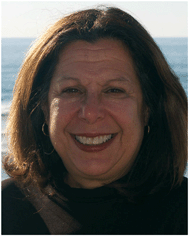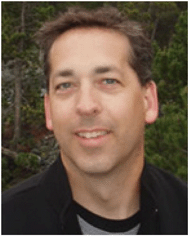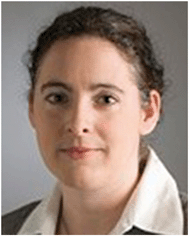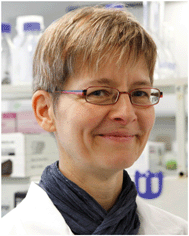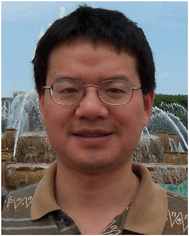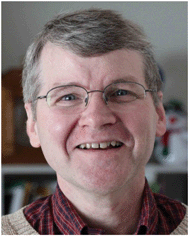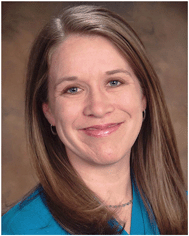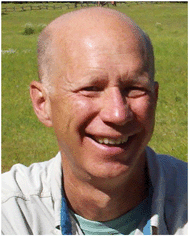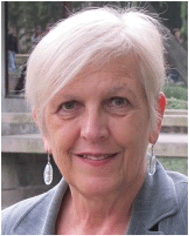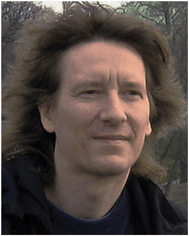Meet the Editorial Board
Vicki Grassian, Editor-in-Chief
University of California San Diego, USA
Vicki H. Grassian is Distinguished Professor at the departments of Chemistry and Biochemistry, Nanoengineering and Scripps Institution of Oceanography at University of California San Diego. She is also Distinguished Chair of Physical Chemistry and Co-Director of the Center for Aerosol Impacts on Climate and the Environment. Her research is on the chemistry and impacts of particles from nanometre to micrometre scales. In particular, her research is focused on environmental and health aspects of nanoscience and nanotechnology, surface chemistry of environmental interfaces, heterogeneous atmospheric chemistry and the climate, and health impacts of atmospheric aerosols.
Greg Lowry, Associate Editor
Carnegie Mellon University, USA
Dr Gregory Lowry is a Professor in the Department of Civil and Environmental Engineering at Carnegie Mellon University. Prior to this, he carried out his PhD and post-doctoral research at Stanford University until 2001. His research interests include mineral–organic macromolecule–water interfacial processes, and transport and reaction in porous media, with a focus on the fundamental physical/geochemical processes affecting the fate of engineered nanomaterials and organic contaminants in the environment. He is also investigating the processes affecting the permanence of CO
2 injected underground for carbon sequestration. He is an experimentalist working on a variety of fundamental and application-oriented research projects developing novel environmental technologies for restoring contaminated sediments and groundwater. His current projects include
in situ sediment management using innovative sediment caps and DNAPL source zone remediation through delivery of reactive nanoparticles to the NAPL–water interface. He is currently the Deputy Director of the Center for Environmental Implications of NanoTechnology (CEINT).
Iseult Lynch, Associate Editor
University of Birmingham, UK
Iseult Lynch is a physical chemist specialising in understanding the interface between engineered nanomaterials and the environment (biotic and abiotic components) and how this determines their ultimate fate and behaviour. She has been actively involved in research to elucidate the mechanisms involved in potential toxicity of nanomaterials, including being centrally involved in the pioneering studies regarding the nanoparticle–protein corona, for which she received the US National Academy of Sciences Cozzarelli Prize for 2007 (with her co-authors). She is now applying these concepts to assessing nanomaterial behaviour in more complex environments and whole organisms, looking for example at the role of secreted proteins and polysaccharides as well as dissolved organic matter in determining nanomaterials’ environmental fate, transformation and biouptake. Her expertise spans nanomaterials synthesis, characterization and environmental interactions (biomolecules, cells, organisms).
Kristin Schirmer, Associate Editor
Swiss Federal Institute of Aquatic Science and Technology, Eawag, Switzerland
Professor Kristin Schirmer is presently the Head of the Department of Environmental Toxicology at the Swiss Federal Institute of Aquatic Science and Technology, Eawag, Switzerland. She studied for her PhD in Canada, at the University of Waterloo, Ontario, and remains an Adjunct Assistant Professor at the University. Her undergraduate studies in biology were completed at the University of Hohenheim, Germany. Kristin has vast experience within biological environmental research; in 2007 she received three separate awards for her achievements: the SETAC Environmental Education Award, the Felix-Wankel Animal Welfare Education Award and the Technology Transfer Award for the ceramic taximeter passive sampler. Kristin's primary research interest is in environmental toxicology and animal cell biology. She has a particular interest in how environmental contaminants, including engineered nanoparticles, interact with vertebrate cells and her work focuses on compartment water, applying piscine and mammalian cell models. Currently, Kristin is working towards linking changes on the molecular level and whole organism effects and the advancement of
in vitro approaches to enable resource-efficient environmental monitoring and a reduction in the use of animals in toxicology.
Wei-Guo Song, Associate Editor
Institute of Chemistry, Chinese Academy of Sciences, China
Dr Wei-Guo Song is a Professor in the Institute of Chemistry at the Chinese Academy of Sciences (ICCAS). He is also a Professor at the University of Chinese Academy of Sciences. He obtained his BSc from Peking University in 1992, and his PhD from the University of Southern California in 2001. He joined ICCAS in 2005, and received National Distinguished Young Scholar award in 2007. His research group focuses on the design of nanoporous materials and their properties. More specifically, he is interested in using nanoporous materials as adsorbents for inorganic pollutants, and as heterogeneous catalysts for catalytic degradation of organic pollutants. He is also interested in developing high performance catalysts including noble metal catalysts, solid acid/base catalysts, non-metal catalysts,
etc. for fine chemical and pharmaceutical industries.
Robert Hamers, Editorial Board Member
University of Wisconsin-Madison, USA
Professor Robert Hamers first completed his undergraduate studies at the University of Wisconsin, before moving to Cornell University, where he studied for a Masters and then completed a PhD with the thesis title: “State-to-state energy transfer in molecule-surface collisions: NO/Ir(111)”. Currently, Robert is a Professor in the Department of Chemistry at the University of Wisconsin-Madison, a Department which he chaired between 2007–2010. In addition, Robert holds an Arthur Adamson Professorship in Chemistry and is the CTO and Co-Founder of Ilatonix, Inc., a company commercializing organosilicon electrolytes for safer lithium ion batteries. Robert contributed to the Frontiers in Chemical Research Distinguished Lecturer Series, Texas A&M University, and in 2012 won an American Chemical Society National Award in colloid and surface chemistry. Robert's research interests predominantly focus on environmental health and safety of nanomaterials. His research investigates the environmental impacts and potential safety issues associated with release of nanomaterials in the environment and his team are engaged in research projects aimed at understanding how the size, shape, and surface functional groups impact the bioavailability and toxicity of nanomaterials. He is particularly interested in the biochemical effects of nanoparticles, addressing questions such as “how do nanoparticles impact protein folding processes?” and “do nanoparticles induce genetic mutations or other trans-generational effects?”.
Christy Haynes, Editorial Board Member
University of Minnesota, USA
Christy Haynes is an Associate Professor at the University of Minnesota. Her research group focuses on the applications of analytical chemistry in the fields of immunology and toxicology, with particular interest in nanotoxicology. Christy herself studied at Macalester College in St. Paul, MN, where she graduated with a major in Chemistry and minors in Mathematics & Spanish. She then moved to Northwestern University in Evanston, IL, for doctoral work in plasmonic nanoparticles, where she completed a thesis titled: “Fundamentals and Applications of Nanoparticle Optics and Surface-Enhanced Raman Scattering”. Previous to her current position at the University of Minnesota, Christy completed post-doctoral research at the University of North Carolina, Chapel Hill, where she focused on applying microelectrode amperometry to probe single immune cell exocytosis. In 2013, she won the Kavli Foundation Emerging Leader in Chemistry Lecture to discuss her group's nanotoxicology research.
Mike Hochella, Editorial Board Member
Virginia Polytechnic Institute and State University, USA
Professor Mike Hochella is a University Distinguished Professor at Virginia Tech, where he works in environmental science and geoscience. His research interests include nanoscience and mineral surface geochemistry, and elucidating the role that these play in earth science, with particular interest in environmental issues. In addition to this, Mike's team work on mineral–microbe interactions from both a geochemical and biochemical perspective and characterise aqueous partitioning reactions at oxide and silicate surfaces. Mike completed his PhD at Stanford University and since then has held Fellow positions at the European Association of Geochemistry, the American Geophysical Union, the American Association for the Advancement of Science, the Geological Society of America, and the Geochemical Society. Throughout his career he has received numerous awards for his contribution to the Earth sciences, including the Dana Medal from the Mineralogical Society of America as well as Fulbright and Humboldt Foundation research fellowships, and has held advisory positions at various U.S. national agencies, including the National Science Foundation and the Department of Energy. He has also served as President of the Geochemical Society and the Mineralogical Society of America.
Barbara Karn, Editorial Board Member
Sustainable Nanotechnology Organisation & George Washington University, USA
Dr Barbara Karn is the Program Director for the Environmental Health and Safety of Nanotechnology at the National Science Foundation. She is also a senior advisor to the Project on Emerging Nanotechnologies at the Woodrow Wilson International Center for Scholars, and co-founder of the Sustainable Nanotechnology Organization. Barbara completed her BS in chemistry at Ohio State University and Masters degrees at Case Western Reserve University and Cleveland State University, before receiving her PhD in Biology and Environmental Sciences at Florida International University. Barbara has extensive experience within the environmental sector, currently focusing on nanotechnology. Previously, she has worked as an environmental scientist at the US Environment Protection Agency (EPA) and built a research program there in Nanotechnology and the Environment. She continues to work in the National Nanotechnology Initiative, a part of the U.S. Office of Science and Technology Policy. She remains a sought-after lecturer on nanotechnology and the environment. Barbara has been the Nanotechnology Scholar at Georgetown University's Program on Science in the Public Interest and was also named one of the Top Ten Experts in nanotechnology environment, health and safety issues by
Nanotechnology Law and Business. She has published extensively within the nanotechnology and environment field.
Frank von der Kammer, Editorial Board Member
University of Vienna, Austria
Dr Frank von der Kammer completed his PhD in 2005 with highest honour at Hamburg University of Technology, in the Department of Environmental Science and Technology. He is currently senior scientist and lecturer, the Head of Nanogeosciences Division and vice Head of the Department for Environmental Geosciences at the University of Vienna. In the past, Frank has acted as a visiting Professor at the University of Pau and at the University of Aix-Marseille, France. Frank's research interests include environmental colloids, their dynamic behaviour and interaction with trace elements, natural nano-scale processes, nanoparticle characterization, engineered nanoparticles in the environment and the application of field flow fractionation to characterize nanoparticles in complex samples. He has published more than 50 peer-reviewed papers within both nano research and nanoparticle characterization.
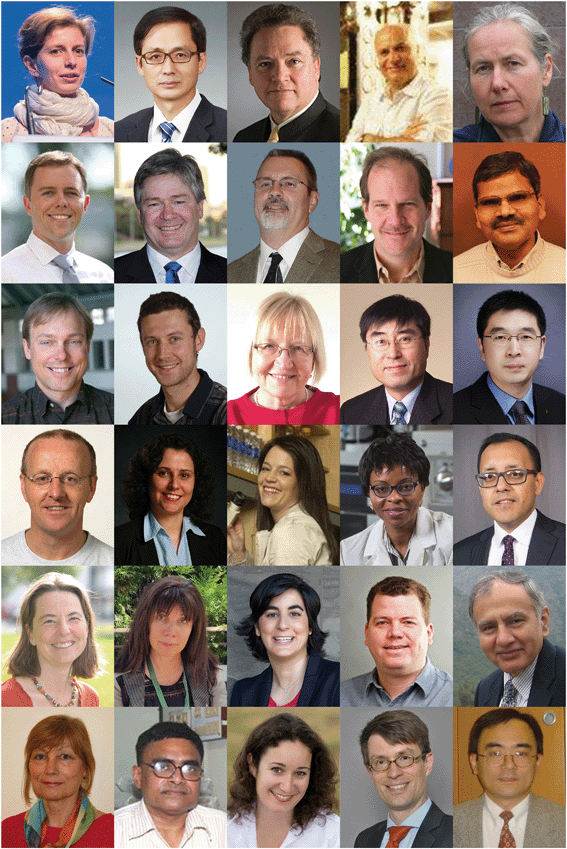 |
| | Fig. 1 Advisory Board members (from left to right; row 1: Melanie Auffan, Yoon-Seok Chang, Kenneth Dawson, Philip Demokritou, Juliane Filser; row 2: John Fortner, Greg Goss, Vincent Hackley, Robert Hurt, Saber Hussain; row 3: James Hutchison, Ralf Kaegi, Anne Kahru, Ki-Bum Kim, Sijin Liu; row 4: Willie Peijnenburg, Debora Rodrigues, Tara Sabo-Attwood, Omowunmi Sadik, Navid Saleh; row 5: Gabriele Schaumann, Vera Slaveykova, Nathalie Tufenkji (photo credit Eva Blue), Jason Unrine, Rajender Varma; row 6: Maria Elena Vela, Nishith Verma, Sharon Walker, Wendel Wohlleben, Weixian Zhang). | |
|
| This journal is © The Royal Society of Chemistry 2017 |
Click here to see how this site uses Cookies. View our privacy policy here. 
